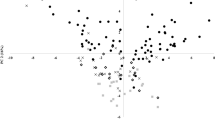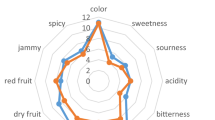Abstract
Ribolla Gialla (RG) is a white grape variety used in the production of high-quality sparkling wines. It is cultivated in a limited area between Friuli Venezia Giulia (FVG—Northeast Italy) and Slovenia; for this reason, there is little information about the composition and chemical characteristics of the sparkling wines produced. This work used different analytical approaches (FTIR spectroscopy, UHPLC–MS/MS, liquid–liquid extraction, SPE and SPME–GC–MS) to characterize thirty-three commercial sparkling RG wines from different areas of FVG. The characteristics included the overall volatile profile and content of terpenes, C13-norisoprenoids, lipids, and metabolites of aromatic amino acids. The aroma profile of RG wines was mainly characterized by fermentative esters and β-damascenone, whereas other norisoprenoids and varietal aromas were below the odor threshold. Appreciable amounts of certain fatty acids were found (e.g., palmitic acid), which could be potentially correlated with greater foam stability. However, high concentrations of aromatic amino acids metabolites highlighted a higher risk of developing atypical aging defects.

Similar content being viewed by others
Change history
11 November 2020
The original article can be found online.
References
Rusjan D, Jug T, Štajner N (2010) Evaluation of genetic diversity: which of the varieties can be named “Rebula” (Vitis vinifera L.)? Vitis 49:189–192
De Lorenzis G, Imazio S, Rusjan D, Vouillamoz JF, Nikolaou N, Failla O, Scienza A (2013) Genetic investigation of grapevine varieties ‘Ribolla Gialla’ (Italy), ‘Rebula’ (Slovenia) and ‘Robola’ (Ionian Islands). Sci Hortic 150:425–431
Imazio S, Scienza A, Brancadoro L, de Lorenzis G, Failla O (2016) Evidence for a sympatric origin of Ribolla Gialla, Gouais Blanc and Schiava cultivars (V. vinifera L.). S Afr J Enol Vitic 35:149–156
Imazio S, De Lorenzis G, Scienza A, Failla O, Vouillamoz J, Korosec-Koruza Z, Rusjan D, Nikolao N (2014) ‘Ribolla Gialla’ from North Eastern Italy, ‘Rebula’ from Northern Balkans and ‘Robola’ from Ionian Islands; do they belong to the same population variety or are they genetically different? Acta Hortic 1046:645–652
Bavčar D, Baša Česnik H, Čuš F, Vanzo A, Gašperlin L, Košmerl T (2011) Impact of alternative skin contact procedures on the aroma composition of white wine. S Afr J Enol Vitic 32:190–203
Bavčar D, Baša Česnik H, Čuš F, Košmerl T (2011) The influence of skin contact during alcoholic fermentation on the aroma composition of Ribolla Gialla and Malvasia Istriana Vitis vinifera (L.) grape wines. Int J Food Sci Technol 46:1801–1808
Rapp A, Versini G (1995) Influence of nitrogen compounds in grapes on aroma compounds of wines. Dev Food Sci 37:1659–1694
Pueyo E, Martínez-Rodríguez A, Polo MC, Santa-María G, Bartolomé G (2000) Release of lipids during yeast autolysis in a model wine system. J Agric Food Chem 48:116–122
Swiegers JH, Bartowsky EJ, Henschke PA, Pretorius IS (2005) Yeast and bacterial modulation of wine aroma and flavour. Aust J Grape Wine Res 11:139–173
Callejón RM, Margulies B, Hirson GD, Ebeler SE (2012) Dynamic changes in volatile compounds during fermentation of Cabernet Sauvignon grapes with and without skins. Am J Enol Vitic 63:301–312
Hirst MB, Richter CL (2016) Review of aroma formation through metabolic pathways of Saccharomyces cerevisiae in beverage fermentations. Am J Enol Vitic 67:361–370
Waterhouse AL, Sacks GL, Jeffery DW (2016) Understanding wine chemistry. Wiley, Chichester
Gallart M, Lopez-Tamames E, Suberbiola G, Buxaderas S (2002) Influence of fatty acids on wine foaming. J Agric Food Chem 50:7042–7045
Hoenicke K, Simat TJ, Steinhart H, Köhler HJ, Schwab A (2001) Determination of free and conjugated indole-3-acetic acid, tryptophan, and tryptophan metabolites in grape must and wine. J Agric Food Chem 49:5494–5501
Schneider V (2014) Atypical aging defect: sensory discrimination, viticultural causes, and enological consequences. A review. Am J Enol Vitic 65:277–284
Dziadas M, Jeleń HH (2010) Analysis of terpenes in white wines using SPE-SPME-GC/MS approach. Anal Chim Acta 677:43–49
Louw L, Tredoux AGJ, Van Rensburg P, Kidd M, Naes T, Nieuwoudt HH (2010) Fermentation-derived aroma compounds in varietal young wines from South Africa. S Afr J Enol Vitic 31:213–225
D’Onofrio C, Matarese F, Cuzzola A (2017) Study of the terpene profile at harvest and during berry development of Vitis vinifera L. aromatic varieties Aleatico, Brachetto, Malvasia di Candia aromatica and Moscato bianco. J Sci Food Agric 97:2898–2907
Vilanova M, Genisheva Z, Graña M, Oliveira JM (2013) Determination of odorants in varietal wines from international grape cultivars (Vitis vinifera) grown in NW Spain. S Afr J Enol Vitic 34:212–222
Loira I, Morata A, Comuzzo P, Callejo MJ, González C, Calderón F, Suárez-Lepe JA (2015) Use of Schizosaccharomyces pombe and Torulaspora delbrueckii strains in mixed and sequential fermentations to improve red wine sensory quality. Food Res Int 76:325–333
Comuzzo P, Marconi M, Zanella G, Querzè M (2018) Pulsed electric field processing of white grapes (cv. Garganega): effects on wine composition and volatile compounds. Food Chem 264:16–23
Carlin S, Vrhovsek U, Franceschi P, Lotti C, Bontempo L, Camin F, Toubiana D, Zottele F, Toller G, Fait A, Mattivi F (2016) Regional features of northern Italian sparkling wines, identified using solid-phase micro extraction and comprehensive two-dimensional gas chromatography coupled with time-of-flight mass spectrometry. Food Chem 208:68–80
Arapitsas P, Guella G, Mattivi F (2018) The impact of SO2 on wine flavanols and indoles in relation to wine style and age. Sci Rep 8:858
Della Corte A, Chitarrini G, Di Gangi IM, Masuero D, Soini E, Mattivi F, Vrhovsek U (2015) A rapid LC–MS/MS method for quantitative profiling of fatty acids, sterols, glycerolipids, glycerophospholipids and sphingolipids in grapes. Talanta 140:52–61
Commission Regulation (EC) No 607/2009 (2009) Laying down certain detailed rules for the implementation of Council Regulation (EC) No 479/2008 as regards protected designations of origin and geographical indications, traditional terms, labeling and presentation of certain wine sector products. Off J Eur Communities L193:60–139
Patynowski RJ, Jiranek V, Markides AJ (2002) Yeast viability during fermentation and sur lie ageing of a defined medium and subsequent growth of Oenococcus oeni. Aust J Grape Wine Res 8:62–69
Comuzzo P, Tat L, Tonizzo A, Battistutta F (2006) Yeast derivatives (extracts and autolysates) in winemaking: release of volatile compounds and effects on wine aroma volatility. Food Chem 99:217–230
Ferreira V, López R, Hernández P, Cacho JF (1999) Identification of impact odorants of young red wines made with Merlot, Cabernet Sauvignon and Grenache grape varieties: a comparative study. J Sci Food Agric 79:1461–1467
Lambrechts MG, Pretorius IS (2000) Yeast and its importance to wine aroma—a review. S Afr J Enol Vitic 21:97–129
Fariña L, Villar V, Ares G, Carrau F, Dellacassa E, Boido E (2015) Volatile composition and aroma profile of Uruguayan Tannat wines. Food Res Int 69:244–255
Ribéreau-Gayon P, Glories Y, Maujean A, Dubourdieu D (2006) Handbook of enology. The chemistry of wine stabilization and treatments, vol 2, 2nd edn. Wiley, Chichester
Ferreira V, Fernandez P, Peiia C, Escudero A (1995) Investigation on the role played by fermentation esters in the aroma-of young Spanish wines by multivariate analysis. J Sci Food Agric 67:381–392
Saerens SMG, Delvaux FR, Verstrepen KJ, Thevelein JM (2010) Production and biological function of volatile esters in Saccharomyces cerevisiae. Microb Biotechnol 3:165–177
Boido E, Medina K, Farina L, Carrau F, Versini G, Dellacassa E (2009) The effect of bacterial strain and aging on the secondary volatile metabolites produced during malolactic fermentation of Tannat red wine. J Agric Food Chem 57:6271–6278
Guth H (1997) Quantitation and sensory studies of character impact odorants of different white wine varieties. J Agric Food Chem 43:35–37
Voce S, Pizzamiglio G, Comuzzo P, Sivilotti S, Mosetti D, Bigot G, Lonardi A (2018) Defogliazione e aromi della Ribolla Gialla. VVQ 10:38–41
Mateo JJ, Jimenez M (2000) Monoterpenes in grape juice and wines. J Chromatogr A 881:557–567
Sefton MA, Skouroumounis GK, Elsey GM, Taylor DK (2011) Occurrence, sensory impact, formation, and fate of damascenone in grapes, wines, and other foods and beverages. J Agric Food Chem 59:9717–9746
Escudero A, Campo E, Fariña L, Cacho J, Ferreira V (2007) Analytical characterization of the aroma of five premium red wines. Insights into the role of odor families and the concept of fruitiness of wines. J Agric Food Chem 55:4501–4510
Belitz HD, Grosch W, Schieberle P (2004) Food chemistry, 3rd edn. Springer, Berlin
Black CA, Parker M, Siebert TE, Capone DL, Francis IL (2015) Terpenoids and their role in wine flavour: recent advances. Aust J Grape Wine Res 21:582–600
Mattivi F, Arapitsas P, Perenzoni D, Guella G (2015) Influence of storage conditions on the composition of red wines. In: Ebeler SB, Sacks G, Vidal S, Winterhalter P (eds) Advances in wine research. ACS Publications, Washington
Hoenicke K, Borchert O, Ning KG, Simat TJ (2002) Untypical aging off-flavor in wine: synthesis of potential degradation compounds of indole-3-acetic acid and kynurenine and their evaluation as precursors of 2-aminoacetophenone. J Agric Food Chem 50:4303–4309
Ramsay AM, Douglas LJ (1979) Effects of phosphate limitation of growth on the cell-wall and lipid composition of Saccharomyces cerevisiae. J Gen Microbiol 110:185–191
Piton F, Charpentier M, Troton D (1988) Cell wall and lipid changes in Saccharomyces cerevisiae during aging of champagne wine. Am J Enol Vitic 39:221–225
Pueyo E, Martin-Alvarez P, Polo MC (1995) Relationship between foam characteristics and chemical composition in wines and cavas (sparkling wines). Am J Enol Vitic 46:518–524
Vilanova M, Sieiro C (2006) Determination of free and bound terpene compounds in Albariño wine. J Food Compos Anal 19:694–697
Francis IL, Newton JL (2005) Determining wine aroma from compositional data. Aust J Grape Wine Res 11:114–126
Sansone-Land A, Takeoka GR, Shoemaker CF (2014) Volatile constituents of commercial imported and domestic black-ripe table olives (Olea europaea). Food Chem 149:285–295
Zhu J, Xiao Z (2018) Characterization of the major odor-active compounds in dry jujube cultivars by application of gas chromatography-olfactometry and odor activity value. J Agric Food Chem 66:7722–7734
Ferreira V, Lopez R, Cacho JF (2000) Quantitative determination of the odorants of young red wines from different grape varieties. J Sci Food Agric 80:1659–1667
Elsharif SA, Buettner A (2018) Structure–odor relationship study on geraniol, nerol, and their synthesized oxygenated derivatives. J Agric Food Chem 66:2324–2333
Acknowledgements
This research was financially supported by Friuli Venezia Giulia Region (LR 29 Dec 2016, n. 25, art. 3, paragraphs 6-10. Project Title: Maturation parameters and optimization of the agronomic and enological techniques for the production of quality sparkling wines, Jul 2017–Dec 2019) and by the ADP 2017 project and PhD scholarship (D.S.) funded by the Autonomous Province of Trento. The authors are grateful to Dr. Matteo Corradin for his cooperation in aroma analyses.
Author information
Authors and Affiliations
Corresponding authors
Ethics declarations
Conflict of interest
The authors declare that they have no conflict of interest.
Compliance with ethics requirements
This research was carried out in compliance with ethical standards.
Additional information
Publisher's Note
Springer Nature remains neutral with regard to jurisdictional claims in published maps and institutional affiliations.
Rights and permissions
About this article
Cite this article
Voce, S., Škrab, D., Vrhovsek, U. et al. Compositional characterization of commercial sparkling wines from cv. Ribolla Gialla produced in Friuli Venezia Giulia. Eur Food Res Technol 245, 2279–2292 (2019). https://doi.org/10.1007/s00217-019-03334-9
Received:
Revised:
Accepted:
Published:
Issue Date:
DOI: https://doi.org/10.1007/s00217-019-03334-9




